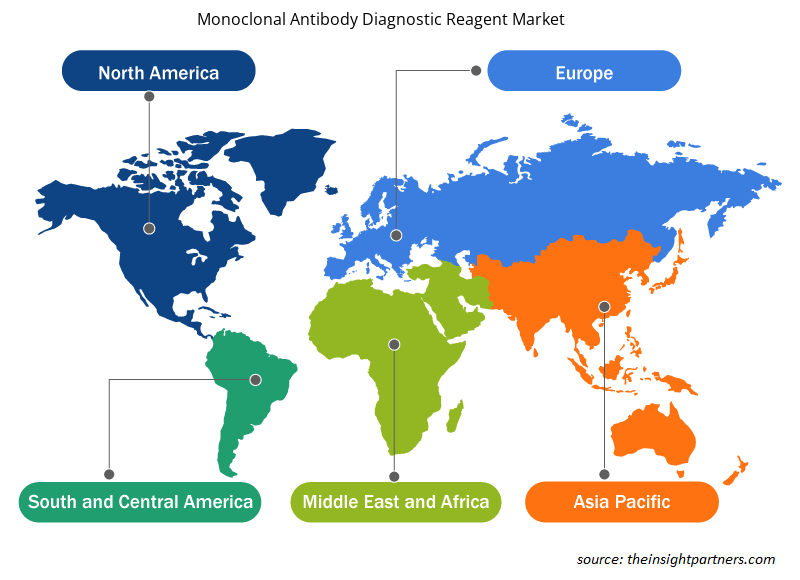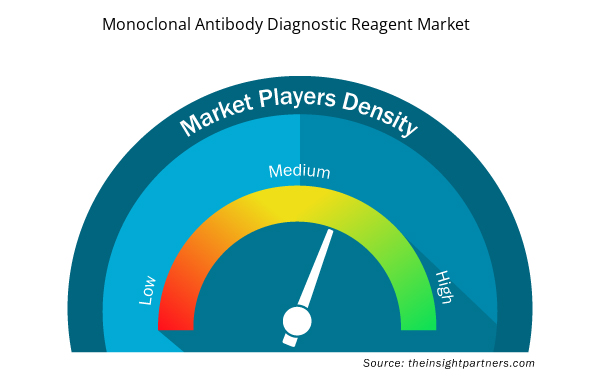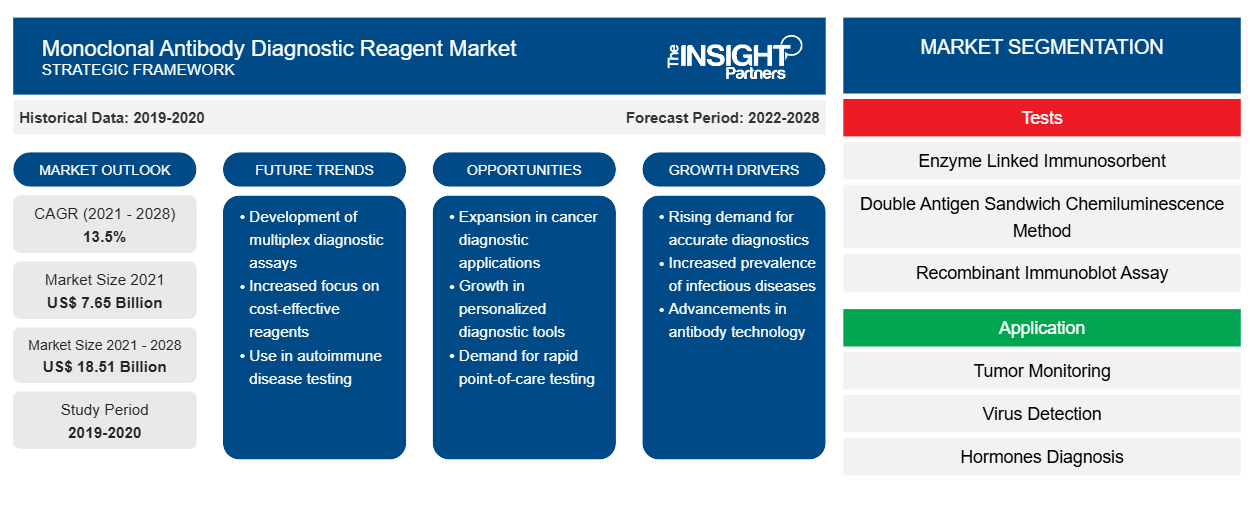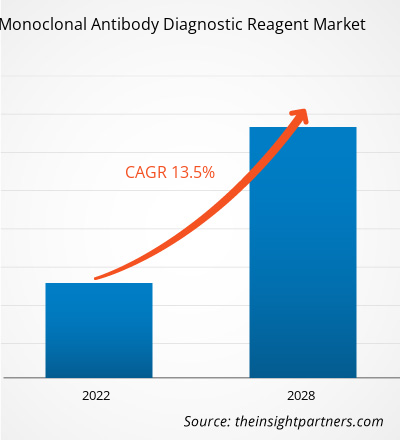El mercado mundial de reactivos de diagnóstico de anticuerpos monoclonales se valoró en US$ 7.654,06 millones en 2021; se estima que crecerá a una CAGR del 13,5% entre 2022 y 2028.
Los anticuerpos monoclonales (mAb) son reactivos de diagnóstico importantes que se utilizan en la investigación biomédica y microbiológica; en el diagnóstico de hepatitis, sida, gripe, herpes simple e infecciones por clamidia; y en el tratamiento de infecciones y cáncer. Los anticuerpos monoclonales dirigidos a epítopos individuales son altamente específicos, homogéneos y se pueden producir en cantidades ilimitadas. La tecnología de anticuerpos monoclonales derivados de hibridomas o clonados bacterianamente ha permitido la producción en masa de sondas altamente específicas para sitios antigénicos, ya sea en hormonas, enzimas, receptores o productos microbianos. Los principales factores que impulsan el crecimiento de este mercado incluyen la creciente prevalencia del cáncer y otras enfermedades crónicas, la presencia de una sólida cartera de medicamentos en fase de prueba y amplios esfuerzos de I+D para desarrollar nuevas terapias.
El informe ofrece información y un análisis profundo del mercado mundial de reactivos de diagnóstico de anticuerpos monoclonales , haciendo hincapié en diversos parámetros, incluidas las tendencias del mercado, los avances tecnológicos, la dinámica del mercado y el análisis del panorama competitivo de los principales actores del mercado mundial. También incluye el impacto de la pandemia de COVID-19 en el mercado en todas las regiones.
El impacto general de la pandemia de COVID-19 en el mercado de reactivos de diagnóstico de anticuerpos monoclonales fue positivo; por lo tanto, el mercado continúa ganando terreno y se espera que crezca en los próximos años. Celltrion Group ha anunciado que el Ministerio de Seguridad de Alimentos y Medicamentos de Corea (MFDS) ha aprobado regdanvimab (CT-P59), un anticuerpo monoclonal para el tratamiento de COVID-19 para el uso prolongado en pacientes de edad avanzada de 50 años o más, o con al menos una condición médica subyacente como obesidad, enfermedad cardiovascular, enfermedad pulmonar crónica, diabetes, enfermedad renal crónica , enfermedad hepática crónica y pacientes con agentes inmunosupresores con síntomas leves de COVID-19, y pacientes adultos con síntomas moderados de COVID-19. Además, la terapia con anticuerpos monoclonales, que se ha utilizado con éxito en otros países para tratar a pacientes con COVID-19 con síntomas leves o moderados, ahora ha sido aprobada por el Controlador General de Medicamentos de la India (DCGI) para su uso en la India.
Personalice este informe según sus necesidades
Obtendrá personalización en cualquier informe, sin cargo, incluidas partes de este informe o análisis a nivel de país, paquete de datos de Excel, así como también grandes ofertas y descuentos para empresas emergentes y universidades.
- Obtenga las principales tendencias clave del mercado de este informe.Esta muestra GRATUITA incluirá análisis de datos, desde tendencias del mercado hasta estimaciones y pronósticos.
Perspectivas basadas en la geografía
Por geografía, el mercado global de reactivos de diagnóstico de anticuerpos monoclonales está segmentado en América del Norte (EE. UU., Canadá y México), Europa (Francia, Alemania, Reino Unido, España, Rusia, Italia y el resto de Europa), Asia Pacífico (China, India, Japón, Australia, Corea del Sur, Kazajstán y el resto de APAC), Medio Oriente y África (Arabia Saudita, Emiratos Árabes Unidos, Sudáfrica y el resto de Medio Oriente y África) y América del Sur y Central (Brasil, Argentina y el resto de América del Sur y Central).
Perspectivas del mercado
Amplios esfuerzos de I+D para desarrollar nuevas terapias
Las numerosas aplicaciones de los mAb incluyen la prevención, el diagnóstico y el tratamiento de enfermedades. La aplicación de los mAb en el diagnóstico es la más avanzada, en particular para las pruebas realizadas en fluidos corporales como la orina y la sangre. Además, la aplicación diagnóstica de los mAb incluye técnicas como ELISA, Western blot, inmunotransferencia, citometría de flujo, inmunohistoquímica, ensayo de radioinmunología y microscopía electrónica. Además, los mAb destinados a la aplicación diagnóstica pueden detectar antígenos y anticuerpos contra enfermedades virales y fúngicas del ganado y enfermedades parasitarias.
Además, los mAb son reactivos valiosos destinados a numerosas aplicaciones debido a su selectividad, alta afinidad de unión e inmunogenicidad/baja toxicidad; los mAb son los más adecuados para la investigación clínica, ambiental y elemental. Las aplicaciones diagnósticas de los mAb también incluyen dispositivos médicos, pruebas in vitro e imágenes médicas.
Además, la utilidad de los mAb se ha ampliado para comprender una variedad de enfermedades, ya que contribuye al desarrollo de nuevos tratamientos de inmunoterapia. Por ejemplo, las terapias contra el cáncer se beneficiaron de la investigación con mAb, probablemente para el desarrollo de RituximAb, que demostró ser un tratamiento eficaz para muchos tipos de cáncer. Además, la Administración de Alimentos y Medicamentos de los Estados Unidos (FDA) reconoce que muchos mAb son seguros para su uso en terapias comerciales. Se espera que los factores mencionados anteriormente contribuyan al crecimiento del mercado de reactivos de diagnóstico de anticuerpos monoclonales durante el período de pronóstico.
Perspectivas regionales del mercado de reactivos de diagnóstico de anticuerpos monoclonales
Los analistas de Insight Partners explicaron en detalle las tendencias y los factores regionales que influyen en el mercado de reactivos de diagnóstico de anticuerpos monoclonales durante el período de pronóstico. Esta sección también analiza los segmentos y la geografía del mercado de reactivos de diagnóstico de anticuerpos monoclonales en América del Norte, Europa, Asia Pacífico, Oriente Medio y África, y América del Sur y Central.

- Obtenga datos regionales específicos para el mercado de reactivos de diagnóstico de anticuerpos monoclonales
Alcance del informe de mercado de reactivos de diagnóstico de anticuerpos monoclonales
| Atributo del informe | Detalles |
|---|---|
| Tamaño del mercado en 2021 | 7.650 millones de dólares estadounidenses |
| Tamaño del mercado en 2028 | US$ 18,51 mil millones |
| CAGR global (2021-2028) | 13,5% |
| Datos históricos | 2019-2020 |
| Período de pronóstico | 2022-2028 |
| Segmentos cubiertos | Por pruebas
|
| Regiones y países cubiertos | América del norte
|
| Líderes del mercado y perfiles de empresas clave |
|
Densidad de actores del mercado de reactivos de diagnóstico de anticuerpos monoclonales: comprensión de su impacto en la dinámica empresarial
El mercado de reactivos de diagnóstico de anticuerpos monoclonales está creciendo rápidamente, impulsado por la creciente demanda de los usuarios finales debido a factores como la evolución de las preferencias de los consumidores, los avances tecnológicos y una mayor conciencia de los beneficios del producto. A medida que aumenta la demanda, las empresas amplían sus ofertas, innovan para satisfacer las necesidades de los consumidores y aprovechan las tendencias emergentes, lo que impulsa aún más el crecimiento del mercado.
La densidad de actores del mercado se refiere a la distribución de las empresas o firmas que operan dentro de un mercado o industria en particular. Indica cuántos competidores (actores del mercado) están presentes en un espacio de mercado determinado en relación con su tamaño o valor total de mercado.
Las principales empresas que operan en el mercado de reactivos de diagnóstico de anticuerpos monoclonales son:
- BioGenex
- Laboratorios Bio-Rad, Inc.
- Biocare Medical, LLC
- Compañía de servicios sanitarios Celltrion, Ltd.
- Diagnóstico creativo
Descargo de responsabilidad : Las empresas enumeradas anteriormente no están clasificadas en ningún orden particular.

- Obtenga una descripción general de los principales actores clave del mercado de reactivos de diagnóstico de anticuerpos monoclonales
Perspectivas basadas en pruebas
Según las pruebas, el mercado mundial de reactivos de diagnóstico de anticuerpos monoclonales se segmenta en el método de quimioluminiscencia sándwich de doble antígeno, el ensayo inmunoabsorbente ligado a enzimas, el ensayo de inmunotransferencia recombinante y el ensayo de filtración de oro por puntos. En 2021, el segmento del ensayo inmunoabsorbente ligado a enzimas representó la mayor participación de mercado y se prevé que registre la CAGR más alta entre 2022 y 2028.
Perspectivas basadas en aplicaciones
Según la aplicación, el mercado mundial de reactivos de diagnóstico de anticuerpos monoclonales se segmenta en diagnóstico de hormonas, monitoreo de tumores, detección de virus y otras aplicaciones. El segmento de monitoreo de tumores tuvo la mayor participación de mercado en 2021 y se espera que registre la CAGR más alta durante el período de pronóstico.
Los actores del mercado global de reactivos de diagnóstico de anticuerpos monoclonales están adoptando estrategias orgánicas, que incluyen el lanzamiento y la expansión de productos, para expandir su presencia y cartera de productos en todo el mundo y satisfacer la creciente demanda de productos. Algunos de los actores clave que operan en el mercado son BioGenex; Bio-Rad Laboratories, Inc.; Biocare Medical, LLC; Celltrion Healthcare Co., Ltd.; Creative Diagnostics; GenWay Biotech; Thermo Fisher Scientific Inc.; ABclonal, Inc.; Apto-Gen; y Abcam plc.
- Análisis histórico (2 años), año base, pronóstico (7 años) con CAGR
- Análisis PEST y FODA
- Tamaño del mercado Valor/volumen: global, regional, nacional
- Industria y panorama competitivo
- Conjunto de datos de Excel


- Virtual Pipeline Systems Market
- Hydrocephalus Shunts Market
- Medical Devices Market
- Skin Graft Market
- Playout Solutions Market
- Photo Editing Software Market
- Analog-to-Digital Converter Market
- Advanced Planning and Scheduling Software Market
- Saudi Arabia Drywall Panels Market
- Aesthetic Medical Devices Market

Report Coverage
Revenue forecast, Company Analysis, Industry landscape, Growth factors, and Trends

Segment Covered
This text is related
to segments covered.

Regional Scope
North America, Europe, Asia Pacific, Middle East & Africa, South & Central America

Country Scope
This text is related
to country scope.
Preguntas frecuentes
The enzyme-linked immunosorbent assay segment held the largest share of the market in the global monoclonal antibody diagnostic reagent market contributing a market share of 37.89% in 2021.
The Asia Pacific is expected to be the fastest-growing region in the monoclonal antibody diagnostic reagent market over the forecast period due to growing investments from international players in China and India, increasing disposable income, and chronic diseases in these regions will show promising growth in the monoclonal antibody diagnostic reagent market.
The monoclonal antibody diagnostic reagent market is expected to be valued at US$ 18,507.20 million in 2028.
The CAGR value of the monoclonal antibody diagnostic reagent market during the forecasted period of 2022-2028 is 13.5%
The monoclonal antibody diagnostic reagent market is estimated to be valued at US$ 8,642.00 million in 2022.
The monoclonal antibody diagnostic reagent market majorly consists of the players, such as BioGenex; Bio-Rad Laboratories, Inc.; Biocare Medical, LLC; Celltrion Healthcare Co., Ltd.; Creative Diagnostics; GenWay Biotech; Thermo Fisher Scientific Inc.; ABclonal, Inc.; Apto-Gen; and Abcam plc.
Rising prevalence of cancer and other chronic diseases, extensive R&D efforts to develop novel therapies, and presence of strong pipeline of drugs under trial are the major factors contributing to the growth of the monoclonal antibody diagnostic reagent industry.
Monoclonal antibodies (mAb) are important diagnostic reagents that are being used in biomedical research, microbiological research in diagnosis of Hepatitis, AIDs, influenza, herpes simplex, chlamydia infections and in treatment of infections and cancer. The monoclonal antibodies being directed against single epitopes are highly specific, homogeneous and can be produced in unlimited quantities. The hybridoma-derived or bacterially cloned monoclonal antibody technology has enabled the mass production of highly specific probes for antigenic sites, whether on hormones, enzymes, receptors, or microbial products.
Trends and growth analysis reports related to Life Sciences : READ MORE..
The List of Companies - Monoclonal Antibody Diagnostic Reagent Market
- BioGenex
- Bio-Rad Laboratories, Inc.
- Biocare Medical, LLC
- Celltrion Healthcare Co., Ltd.
- Creative Diagnostics
- GenWay Biotech
- Thermo Fisher Scientific Inc.
- ABclonal, Inc.
- Apto-Gen
- Abcam plc.
The Insight Partners performs research in 4 major stages: Data Collection & Secondary Research, Primary Research, Data Analysis and Data Triangulation & Final Review.
- Data Collection and Secondary Research:
As a market research and consulting firm operating from a decade, we have published and advised several client across the globe. First step for any study will start with an assessment of currently available data and insights from existing reports. Further, historical and current market information is collected from Investor Presentations, Annual Reports, SEC Filings, etc., and other information related to company’s performance and market positioning are gathered from Paid Databases (Factiva, Hoovers, and Reuters) and various other publications available in public domain.
Several associations trade associates, technical forums, institutes, societies and organization are accessed to gain technical as well as market related insights through their publications such as research papers, blogs and press releases related to the studies are referred to get cues about the market. Further, white papers, journals, magazines, and other news articles published in last 3 years are scrutinized and analyzed to understand the current market trends.
- Primary Research:
The primarily interview analysis comprise of data obtained from industry participants interview and answers to survey questions gathered by in-house primary team.
For primary research, interviews are conducted with industry experts/CEOs/Marketing Managers/VPs/Subject Matter Experts from both demand and supply side to get a 360-degree view of the market. The primary team conducts several interviews based on the complexity of the markets to understand the various market trends and dynamics which makes research more credible and precise.
A typical research interview fulfils the following functions:
- Provides first-hand information on the market size, market trends, growth trends, competitive landscape, and outlook
- Validates and strengthens in-house secondary research findings
- Develops the analysis team’s expertise and market understanding
Primary research involves email interactions and telephone interviews for each market, category, segment, and sub-segment across geographies. The participants who typically take part in such a process include, but are not limited to:
- Industry participants: VPs, business development managers, market intelligence managers and national sales managers
- Outside experts: Valuation experts, research analysts and key opinion leaders specializing in the electronics and semiconductor industry.
Below is the breakup of our primary respondents by company, designation, and region:

Once we receive the confirmation from primary research sources or primary respondents, we finalize the base year market estimation and forecast the data as per the macroeconomic and microeconomic factors assessed during data collection.
- Data Analysis:
Once data is validated through both secondary as well as primary respondents, we finalize the market estimations by hypothesis formulation and factor analysis at regional and country level.
- Macro-Economic Factor Analysis:
We analyse macroeconomic indicators such the gross domestic product (GDP), increase in the demand for goods and services across industries, technological advancement, regional economic growth, governmental policies, the influence of COVID-19, PEST analysis, and other aspects. This analysis aids in setting benchmarks for various nations/regions and approximating market splits. Additionally, the general trend of the aforementioned components aid in determining the market's development possibilities.
- Country Level Data:
Various factors that are especially aligned to the country are taken into account to determine the market size for a certain area and country, including the presence of vendors, such as headquarters and offices, the country's GDP, demand patterns, and industry growth. To comprehend the market dynamics for the nation, a number of growth variables, inhibitors, application areas, and current market trends are researched. The aforementioned elements aid in determining the country's overall market's growth potential.
- Company Profile:
The “Table of Contents” is formulated by listing and analyzing more than 25 - 30 companies operating in the market ecosystem across geographies. However, we profile only 10 companies as a standard practice in our syndicate reports. These 10 companies comprise leading, emerging, and regional players. Nonetheless, our analysis is not restricted to the 10 listed companies, we also analyze other companies present in the market to develop a holistic view and understand the prevailing trends. The “Company Profiles” section in the report covers key facts, business description, products & services, financial information, SWOT analysis, and key developments. The financial information presented is extracted from the annual reports and official documents of the publicly listed companies. Upon collecting the information for the sections of respective companies, we verify them via various primary sources and then compile the data in respective company profiles. The company level information helps us in deriving the base number as well as in forecasting the market size.
- Developing Base Number:
Aggregation of sales statistics (2020-2022) and macro-economic factor, and other secondary and primary research insights are utilized to arrive at base number and related market shares for 2022. The data gaps are identified in this step and relevant market data is analyzed, collected from paid primary interviews or databases. On finalizing the base year market size, forecasts are developed on the basis of macro-economic, industry and market growth factors and company level analysis.
- Data Triangulation and Final Review:
The market findings and base year market size calculations are validated from supply as well as demand side. Demand side validations are based on macro-economic factor analysis and benchmarks for respective regions and countries. In case of supply side validations, revenues of major companies are estimated (in case not available) based on industry benchmark, approximate number of employees, product portfolio, and primary interviews revenues are gathered. Further revenue from target product/service segment is assessed to avoid overshooting of market statistics. In case of heavy deviations between supply and demand side values, all thes steps are repeated to achieve synchronization.
We follow an iterative model, wherein we share our research findings with Subject Matter Experts (SME’s) and Key Opinion Leaders (KOLs) until consensus view of the market is not formulated – this model negates any drastic deviation in the opinions of experts. Only validated and universally acceptable research findings are quoted in our reports.
We have important check points that we use to validate our research findings – which we call – data triangulation, where we validate the information, we generate from secondary sources with primary interviews and then we re-validate with our internal data bases and Subject matter experts. This comprehensive model enables us to deliver high quality, reliable data in shortest possible time.


 Obtenga una muestra gratuita de este informe
Obtenga una muestra gratuita de este informe